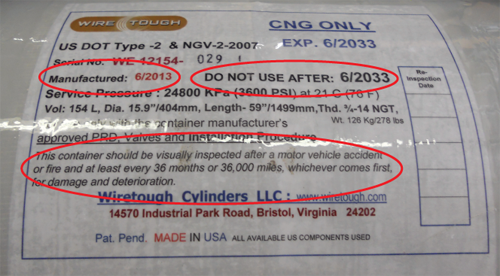CNG Fuel System and Tank Maintenance
Compressed natural gas (CNG) fuel systems require different maintenance than conventional fuel systems. Technicians should regularly inspect and replace the fuel filter, which removes any oil or contaminants in the fuel. This filter generally needs to be replaced annually by a qualified service facility; owners should check their owner's manual for the specific requirements of their vehicle. In some cases, filters should be drained of any contaminants on a more regular basis, depending upon the application.
CNG Tank End-of-Life

CNG fuel tanks have a useful life of 15 to 20 years, depending on their construction and how they were certified by the original manufacturer. Because there is no way to safely "requalify" tanks for extended use, once a tank reaches its expiration date, it must be replaced. All CNG tanks carry a label that indicates "DO NOT USE AFTER (EXPIRATION DATE)." For instance, it might read "DO NOT USE AFTER 01/2027." The CNG tank expiration date may also be found on a label near the fueling connector or on a label under the hood. CNG vehicle owners should make a habit of noting the expiration date at routine service intervals. They should also be aware that there is no national system to notify owners when their tanks reach their expiration date; it is the vehicle owner's or fleet manager's responsibility to have the tank replaced at the end of its life. For more information on CNG tank end-of-life issues, see the Compressed Natural Gas Fuel Tank Defueling, Decommissioning, and Disposal video.
CNG Tank Replacement
CNG tanks should be replaced by a qualified service facility. This type of service facility will include properly trained personnel and equipment to safely vent the CNG from the tank and purge the tank with nitrogen to eliminate any pressure or fire danger associated with residual CNG in the tank. Once the tank is safely purged of any natural gas, the expired CNG tank must be rendered unusable and discarded. See the Compressed Natural Gas Fuel Tank Defueling, Decommissioning, and Disposal video or CSA EXP 2.1, Defueling, decommissioning, and disposal of compressed natural gas vehicle fuel containers best practices document for more information.
CNG Storage Tank Inspection
Performing a regular safety inspection of the CNG storage tanks is a critical maintenance requirement for CNG fuel systems. Damage from road debris can threaten the integrity of CNG tanks. Exposure to certain chemicals may cause corrosion and cracking as well. Because these tanks are pressurized to 3,600 pounds per square inch (psi), what appears to be insignificant damage could pose significant danger due to tank quality degradation. For these reasons, tanks on vehicles with a gross vehicle weight rating greater than 10,000 lbs should be inspected in a qualified service facility once every year (12 months). Light-duty vehicle tanks should be inspected every three years (36 months) or every 36,000 miles, whichever comes first (U.S. DOT National Highway Traffic Safety Administration FMVSS 304). In addition, tanks must be inspected after any fire, accident, or other incident that could cause damage to the tank.
Tanks that are mounted in the underbody of a vehicle are at higher risk of impact by debris on the road or becoming damaged from impact, such as driving over a curb. Owners can locate certified inspectors by searching for "Certified CNG Fuel System Inspector" on the CSA Group website or using the Alternative Fuel Vehicle Institute's Certified Inspector Lookup Tool. The CSA Group is the standards-writing body in the United States for natural gas appliances and related equipment.
New CNG vehicles will have labels located on the tank, near the fueling connector, or under the hood in the engine compartment defining the tank inspection and expiration dates. For used vehicles, owners should obtain the most recent inspection record from the previous owner and should have a qualified service facility perform a new inspection before purchasing the vehicle. Likewise, if purchasing one or more used CNG tanks for a converted vehicle, buyers should verify the tank has a sufficient useful lifetime left before the defined expiration date (see above) and have the tank inspected by a certified CNG fuel system inspector.
After the first inspection, vehicle owners or fleet managers should keep a record of the most recent inspection and when the next one is due. Many inspection facilities provide reminder stickers for oil changes that list the date and mileage when the next oil change is due; it is recommended to use these reminder stickers for CNG tank inspections as well. CNG vehicle owners may even have two reminder stickers, one for oil and one for the tank inspection.